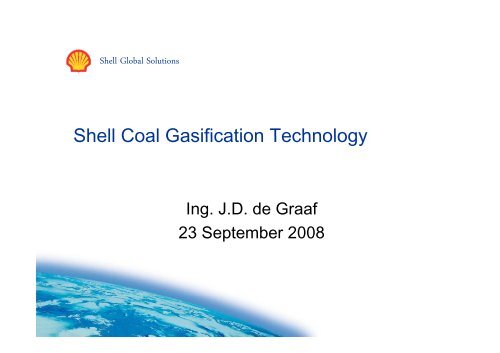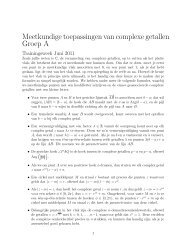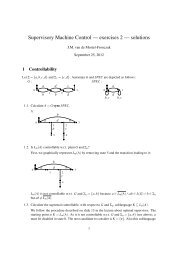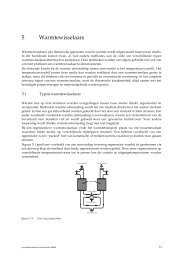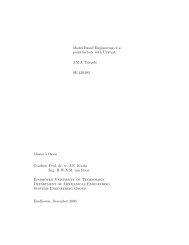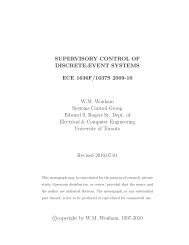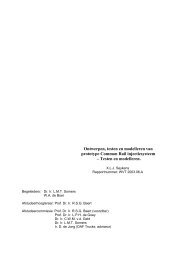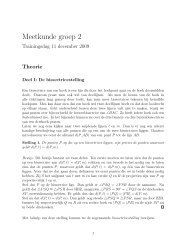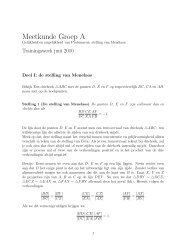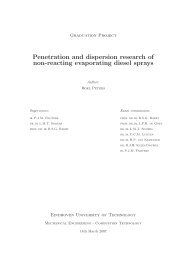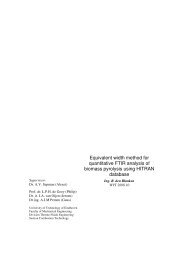Shell Coal Gasification Technology
Shell Coal Gasification Technology
Shell Coal Gasification Technology
Create successful ePaper yourself
Turn your PDF publications into a flip-book with our unique Google optimized e-Paper software.
<strong>Shell</strong> Global Solutions<br />
<strong>Shell</strong> <strong>Coal</strong> <strong>Gasification</strong> <strong>Technology</strong><br />
Ing. J.D. de Graaf<br />
23 September 2008
Disclaimer statement<br />
<strong>Shell</strong> Global Solutions is a network of independent technology companies in the <strong>Shell</strong><br />
Group. In this document, the expressions “<strong>Shell</strong>” or “<strong>Shell</strong> Global Solutions” are<br />
sometimes used for convenience where reference is made to these companies in<br />
general, or where no useful purpose is served by identifying a particular company.<br />
The information contained in this material is intended to be general in nature and must<br />
not be relied on as specific advice in connection with any decisions you may make.<br />
<strong>Shell</strong> and <strong>Shell</strong> Global Solutions are not liable for any action you may take as a result<br />
of you relying on such material or for any loss or damage suffered by you as a result of<br />
you taking this action. Furthermore, these materials do not in any way constitute an<br />
offer to provide specific services.<br />
Some services may not be available in certain countries or political subdivisions<br />
thereof.<br />
Copyright © 2008 <strong>Shell</strong> Global Solutions International BV. All rights reserved. ed No part<br />
of this publication may be reproduced or transmitted in any form or by any means,<br />
electronic or mechanical including by photocopy, recording or information storage and<br />
retrieval system, without permission in writing from <strong>Shell</strong> Global Solutions International<br />
BV.<br />
<strong>Shell</strong> Global Solutions 2
<strong>Shell</strong> gasification processes – operating<br />
conditions<br />
Natural gas<br />
Refinery gas<br />
SGP @ ~1,400 400°C, 35–60 bar<br />
Vacuum residue<br />
Vacuum flashed cracked residue<br />
Asphalts<br />
Orimulsion<br />
SGP @ ~1,320°C, 35–65 bar<br />
(Non-slagging condition)<br />
Coke<br />
SCGP @ ~1,600°C, 25–45 bar<br />
Bituminous coal<br />
SCGP @ ~1,500°C, 25–45 bar<br />
Lignite<br />
SCGP @ ~1,500°C, 25–45 5bar<br />
Anthracite<br />
SCGP @ ~1,600°C, 25–45 bar<br />
(Slagging condition)<br />
<strong>Shell</strong> Global Solutions 3
<strong>Shell</strong> gasification processes – operating<br />
conditions<br />
Coke<br />
Bituminous coal<br />
Lignite<br />
Anthracite<br />
SCGP @ ~1,600°C, 25–45 bar<br />
SCGP @ ~1,500°C, 25–45 bar<br />
SCGP @ ~1,500°C, 25–45 bar<br />
SCGP @ ~1,600°C, 25–45 bar<br />
(Slagging condition)<br />
Addition of various amounts of solid hydrocarbons is possible, including:<br />
• Biomass<br />
• Demolition wood<br />
• Sewage sludge<br />
• Coffee/rice/milk powder<br />
• Paper pulp<br />
• Chicken litter<br />
<strong>Shell</strong> Global Solutions 4
<strong>Shell</strong> gasification processes – feedstock<br />
flexibility<br />
<strong>Gasification</strong> feedstock flexibility<br />
Heating value (LHV)<br />
Ash content<br />
Sulphur content<br />
Chlorine content<br />
16–40 MJ/kg<br />
(< 1) –40 % wt<br />
0.5–7 % wt<br />
100–2,000 ppm wt<br />
Gasifier Form C/ H ratio<br />
wt<br />
Sulphur<br />
%wt<br />
<strong>Coal</strong> SCGP Solid 16.2 2.69<br />
Petroleum coke SCGP Solid 27.7 7.0<br />
Brown coal SCGP Solid 12.2 0.71<br />
Visbreaker residue SGP Liquid 9.7 5.0<br />
Liquid coke (DTC® ) SGP Liquid 11.9 8.0<br />
Asphalt SGP Liquid 9.5 6.0<br />
SCGP module<br />
<strong>Gasification</strong><br />
building<br />
SCGP – <strong>Shell</strong> <strong>Coal</strong> <strong>Gasification</strong> Process<br />
SGP – <strong>Shell</strong> <strong>Gasification</strong> Process<br />
<strong>Shell</strong> Global Solutions 5
<strong>Shell</strong> gasification processes – dedicated to<br />
feedstock<br />
Liquid refinery residues<br />
SGP<br />
<strong>Coal</strong> and coke<br />
SCGP<br />
Differences<br />
SGP: Non-slagging condition<br />
SGP: Refractory lined gasifier<br />
SGP: Liquid feed system<br />
SGP: Fire tube boiler<br />
SGP: Soot water handling<br />
SCGP: Slagging condition<br />
SCGP: Membrane wall gasifier<br />
SCGP: Dry feed system<br />
SCGP: Water tube boiler<br />
SCGP: Solid slag handling<br />
<strong>Shell</strong> Global Solutions 6
SCGP – membrane wall, protected by the slag layer<br />
Solid slag layer on refractory lining<br />
(Protection for the water tubes)<br />
Water–steam mixture out<br />
(To steam drum)<br />
> 1,500°C<br />
Refractory lining fixed on tubes<br />
(Thickness: – 14 mm [½ in.])<br />
Molten slag flow on solid slag layer<br />
(Downward flow by gravity)<br />
Annular space<br />
240°C (depending on boiler<br />
water temperature)<br />
Water tube<br />
Boiler water in<br />
(Saturated, operating<br />
range 40–70 bar)<br />
<strong>Shell</strong> Global Solutions 7
<strong>Shell</strong> SCGP process line-up<br />
<strong>Coal</strong>/petcoke<br />
Fly ash<br />
recirc.<br />
Quench gas<br />
Milling/drying<br />
Gasifier<br />
900°C<br />
HP steam<br />
MP steam<br />
<strong>Coal</strong> feeding<br />
1,600°C<br />
Dry solids<br />
Removal<br />
Wet<br />
scrubbing<br />
Raw<br />
syngas<br />
Slag<br />
Fly ash<br />
system<br />
Water<br />
treatment<br />
Fly ash to<br />
milling and drying<br />
(if required)<br />
Salts<br />
<strong>Shell</strong> Global Solutions 8
SCGP – advantages<br />
• High availability and low maintenance cost owing to the robustness of the<br />
membrane wall gasifier and the long life time of coal burners<br />
• High throughput through multiple burners<br />
• Efficient use of coal (low operating expenditure) and low CO 2 emissions<br />
resulting from complete conversion of any coal/coke (carbon conversion<br />
>99%)<br />
• High cold gas efficiency resulting in the production of more syngas from the<br />
same amount of coal/coke owing to the optimised operating temperature<br />
• High flexibility to feedstocks (most coal types and petroleum coke)<br />
• High operating flexibility with respect to short-term coal quality changes<br />
<strong>Shell</strong> Global Solutions 9
SCGP – typical energy balance<br />
<strong>Coal</strong> in 100%<br />
2.0% Steam from reactor wall (reused)<br />
12.8% Steam from Syngas cooler (reused)<br />
0.5% Unconverted carbon (fly ash/slag)<br />
2.7% Low-level heat (cooling of slag)<br />
82%<br />
18.0% Total<br />
Raw synthesis gas<br />
<strong>Shell</strong> Global Solutions 10
Nuon IGCC, Buggenum, the Netherlands<br />
• Integrated coal gasification combined-cycle cycle power plant<br />
• Commissioned in 1994 as a demonstration plant<br />
• Commercial operation since 1998<br />
• 2,000 tonne/day coal producing 4.0 × 106 Nm 3 syngas<br />
Energy balance:<br />
<strong>Coal</strong> intake<br />
585 MWe<br />
Gas turbine output 156 MWe<br />
Steam turbine output 128 MWe<br />
Total output<br />
284 MWe<br />
Own consumption 31 MWe<br />
Courtesy<br />
Nuon<br />
Net output<br />
253 Mwe<br />
Net efficiency (LHV) 43 %<br />
<strong>Shell</strong> Global Solutions 11
Buggenum block diagram<br />
Stack<br />
<strong>Coal</strong><br />
Steam<br />
Steam<br />
Waste heat<br />
boiler<br />
Steam<br />
<strong>Coal</strong><br />
treatment<br />
and supply<br />
<strong>Coal</strong><br />
gasification<br />
Gas cooling<br />
and<br />
purification<br />
Gas turbine<br />
Generator<br />
Steam<br />
turbine<br />
Nitrogen<br />
Oxygen<br />
Electricity<br />
Sulphur<br />
Water<br />
<strong>Gasification</strong>/gas treating<br />
production purification<br />
Air separation<br />
Air<br />
separation<br />
Air<br />
Combined cycle<br />
Waste water treating<br />
Slag<br />
Sulphur<br />
Salts<br />
<strong>Shell</strong> Global Solutions 12
SCGP – <strong>Coal</strong> properties operated at Nuon<br />
Composition, wt%<br />
Moisture (AR) 4.7–12.1<br />
Ash (MF) 4.5–16.2<br />
Oxygen (MF) 52 5.2–14.0<br />
Sulphur (MF) 0.6–1.1<br />
Chlorine (MF) 0.01–0.15<br />
Ash composition wt% ash<br />
SiO 2 , wt% 45.1–59.8<br />
Fe 2 O 3 , wt% 3.3–12.4<br />
Al 2 O 3 ,wt% 19.1–32.8<br />
CaO, wt% 0.7– 6.9<br />
K 2 O, wt% 0.6–2.3<br />
Na 2 O, wt% 03 0.3–1.4 14<br />
HHV, kJ/kg, MF 27,200–32,900<br />
Legend<br />
AR – as received<br />
MAF – moisture and ash free<br />
MF – moisture free<br />
Flux<br />
If required, a flux (such as limestone)<br />
can be added to optimise the gasification<br />
temperature and oxygen consumption!<br />
<strong>Shell</strong> Global Solutions 13
Buggenum – SCGP operation capabilities<br />
Capability of load following<br />
• <strong>Gasification</strong> island: > 5% load per minute<br />
• Total IGCC with SCGP: > 3% load per minute<br />
• Limitation: Air separation unit<br />
Capability of turndown<br />
• Gasifier turndown: Down to 50%<br />
<strong>Shell</strong> Global Solutions 14
Nuon IGCC plant, clean coal technology<br />
aspects<br />
• Extremely low NOx, typically below 10 ppm<br />
• Sulphur removal efficiency over 99%<br />
• Total acidification components NOx + SO 2 : coal<br />
gas operation better than natural gas<br />
• Virtually zero emission of fly ash, chlorides and<br />
volatile heavy metals<br />
• Zero discharge: waste water reused in plant<br />
Courtesy of Nuon<br />
<strong>Shell</strong> Global Solutions 15
NOx emissions – Buggenum IGCC<br />
<strong>Coal</strong> gas better than natural gas operation<br />
Buggenum operating data<br />
<strong>Shell</strong> Global Solutions 16
Buggenum – availability of SCGP and power<br />
plant<br />
Availability gasification unit and on stream time of complete ICGCC period: May 1997 to May 2004<br />
Perc cent [%]<br />
100.0<br />
90.0<br />
80.0<br />
70.0<br />
60.0<br />
50.0<br />
40.0<br />
30.0<br />
20.0<br />
10.0<br />
00 0.0<br />
1997 1998 1999 2000 2001 2002 2003 2004 2005<br />
Time [Year]<br />
Availability gasification unit<br />
On-stream ICGCC<br />
Reasons of trips:<br />
Year Cause Solution<br />
2000 - Plugging slag bath system Crusher and operations<br />
- Leakage SGC Modified construction<br />
- Heat skirt Water cooled heat skirt<br />
2002 - Extend of shutdown appr 4 weeks. Reviewing and Updating maintenance procedures<br />
- Leakage in slagbath system Change of material from carbon steel to duplex steel<br />
- Leakage in SGC. Modified construction<br />
<strong>Shell</strong> Global Solutions 17
Buggenum – availability of SCGP and power<br />
plant<br />
<strong>Gasification</strong> from May 1997 to May 2004<br />
Nuon gasification availability average in 8 years<br />
87%<br />
Unplanned outage average in 8 years<br />
13%<br />
Unplanned outage 13%<br />
Technical items modified d design 4%<br />
Due to frequent coal switches (every 5 days) 5%<br />
Residual unplanned due to mixed items 4%<br />
Planned outage average in 8 years 13%<br />
Conclusion<br />
Planned outage<br />
Nuon as part of power grid (backup available) 13%<br />
<strong>Shell</strong> expected gasification outage 6%<br />
A well-designed, maintained and operated plant should be able to achieve:<br />
Unplanned 4%<br />
Planned 6%<br />
Total outage 10%<br />
<strong>Shell</strong> Global Solutions 18
SCGP – membrane wall gasifier<br />
manufacturing<br />
Membrane wall being manufactured in the workshop (Yingcheng)<br />
Courtesy of Babcock Borsig Espana, Bilbao, Spain<br />
<strong>Shell</strong> Global Solutions 19
Research and development in the 1970s and 1980s<br />
Clean coal<br />
development<br />
SCGP pilot plant<br />
Amsterdam<br />
SCGP demonstration<br />
plant Harburg<br />
SCGP demonstration<br />
plant Houston<br />
Oil/residue gasification<br />
and gas to liquids (GTL)<br />
development<br />
GTL laboratory<br />
Amsterdam<br />
GTL pilot plant<br />
Amsterdam<br />
20–30 years of operating experience<br />
<strong>Shell</strong> Global Solutions 20
SCGP-1 in Deer Park (USA)<br />
Capacity 250–400 tpd<br />
Campaign 1987–1991<br />
<strong>Shell</strong> Global Solutions 21
SCGP – gasification performance at<br />
SCGP-1 Carbon<br />
CGE<br />
(%HHV)<br />
conversion<br />
Illinois #5 99.7 81.6<br />
Maple Creek 98.7 76.0<br />
Drayton 99.6 79.3<br />
Buckskin 99.7 78.0<br />
Blacksville #2 99.7 80.5<br />
Pyro #9 99.9 78.3<br />
Sufco 99.9 81.0<br />
Texas Lignite it 99.4 80.3<br />
Pike County (washed) 99.9 80.9<br />
Pike County (ROM) 99.9 83.0<br />
Dotiki 99.9 80.1<br />
Newlands 99.7 80.3<br />
El Cerrejon 99.6 83.4<br />
Skyline 99.9 82.4<br />
Robinson Creek 99.7 82.22<br />
R&F 99.5 79.6<br />
Pocahontas #3 99.3 82.4<br />
Petroleum coke 99.5 78.9<br />
CGE =<br />
HHV of sweet gas<br />
HHV of coal feed<br />
<strong>Shell</strong> Global Solutions 22
SCGP – coal properties tested at SCGP-1<br />
Proximate analysis, wt%<br />
Moisture (AR) 3.7–34.0<br />
Ash (MAF) 0.5–35.0<br />
VM (MF) 10.6–45.6<br />
Fixed C (MF) 39.1–88.5<br />
Ultimate analysis<br />
Carbon, wt%, MF 56.4–88.7<br />
Hydrogen, wt%, MF 3.6– 5.3<br />
Nitrogen, wt%, MF 11 1.1–1.7 17<br />
Sulphur, wt%, MF 0.3–5.2<br />
Chlorine , wt%, MF 0.01–0.41<br />
Oxygen, wt%, MF 01 0.1–16.416 (by difference)<br />
HHV, kJ/kg, MF 22,980–33,200<br />
Legend<br />
AR – as received<br />
MAF – moisture and ash free<br />
MF – moisture free<br />
<strong>Shell</strong> Global Solutions 23
SCGP – ash properties tested at SCGP-1<br />
Ash minerals<br />
P 2 O 5 , wt% 01 0.1–1.5 15<br />
SiO 2 , wt% 24.4–56.6<br />
Fe 2 O 3 , wt% 5.5–27.8<br />
Al 2 O 3 , wt% 9.5–33.3<br />
TiO 2 , wt% 0.6–2.1<br />
CaO, wt% 1.4–24.5<br />
MgO, wt% 0.3–3.7<br />
SO 3 , wt% 0.9–33.1<br />
K 2 O, wt% 0.1–3.9<br />
Na 2 O, wt% 0.1–3.1<br />
Flux<br />
If required a flux(such as limestone) is<br />
added to optimise the gasification<br />
temperature and oxygen consumption!<br />
Ash melting temperatures at reducing<br />
atmosphere<br />
Fluid point, °C 1,190– >1,500<br />
<strong>Shell</strong> Global Solutions 24
Partial water quench – process flow<br />
Water<br />
quench<br />
Dry solids<br />
removal<br />
Process<br />
condensate<br />
Wet scrubber<br />
Raw syngas to<br />
shift<br />
Fly<br />
ash<br />
N 2 /CO 2<br />
Oxygen<br />
coal<br />
Bleed<br />
Slag<br />
<strong>Shell</strong> Global Solutions 25
Syngas cooler – water quench<br />
Syngas cooler<br />
design<br />
Water quench<br />
design<br />
Spray water<br />
Syngas cooler<br />
Quench<br />
chamber<br />
Gasifier<br />
Gasifier<br />
<strong>Shell</strong> Global Solutions 26
SCGP water quench – a change for the<br />
better…<br />
• Enables gasification of coals that cannot be processed with a<br />
syngas cooler owing to fouling<br />
- High sodium/chlorine content<br />
• Reduces capital expenditure<br />
- No syngas cooler<br />
- No candle filter<br />
- Simpler shift line-up<br />
• Improves integration with a downstream shift for chemical<br />
applications<br />
- Water is added directly to the syngas, not via a saturator<br />
cycle in the shift section<br />
<strong>Shell</strong> Global Solutions 27
…but stick to the key advantages of SCGP<br />
• Membrane wall, heat protection of the gasifier through water<br />
cooling and steam production<br />
• Separate gas and slag outlets t for processing high-ash h h coals<br />
• Multiple burners offer large capacities and efficient slag<br />
removal with only a small amount of fines<br />
• Proven scale-up rules for gasifier<br />
• Dry fly ash removal (as much as possible) limits the amount<br />
of black/grey wastewater/slurry<br />
<strong>Shell</strong> Global Solutions 28
General IGCC SGC compared with water quench<br />
Disadvantages of water quench (WQ) for IGCC applications<br />
• IGCC efficiency 2–4%-points less with WQ SCGP and no carbon<br />
capture system<br />
• More low-temperature syngas cooling (multiple KT-reboilers)<br />
• More water handling (with absence dry fly ash removal)<br />
Main advantage<br />
• Handling of fouling coals for which syngas cooler is not feasible<br />
<strong>Shell</strong> Global Solutions 29
Discussion and questions<br />
Thank you<br />
<strong>Shell</strong> Global Solutions 30
Back-up slides<br />
Back-up slides<br />
<strong>Shell</strong> <strong>Coal</strong> <strong>Gasification</strong> Process<br />
<strong>Shell</strong> Global Solutions 31
SCGP – dry versus slurry feed:<br />
consequences<br />
320<br />
Consump ption of O 2 2 in kg g/Mwe<br />
H 2 )<br />
kg/kmole (CO +<br />
O 2<br />
300<br />
280<br />
260<br />
240<br />
220<br />
200<br />
16<br />
15<br />
14<br />
13<br />
12<br />
11<br />
10<br />
9<br />
8<br />
50 55 60 65 70 75<br />
Slurry, % wt<br />
50 55 60 65 70 75<br />
Slurry, % wt<br />
Stability of water/coal mixture<br />
Additives required<br />
Higher operating expenditure<br />
Ash content of the coal and<br />
coal quality<br />
Limited it (plugging, mixture stability)<br />
Higher operating expenditure<br />
Higher oxygen consumption<br />
Evaporation of water<br />
Higher capital and operating<br />
expenditure for air separation unit<br />
(Large internal power consumption)<br />
<strong>Shell</strong> Global Solutions 32
SCGP – dry versus slurry feed:<br />
consequences<br />
85<br />
Cold gas efficiency, % LH HV<br />
80<br />
75<br />
70<br />
65<br />
46<br />
50 55 60 65 70 75<br />
Slurry, % wt<br />
Lower syngas quality<br />
Higher amount of CO 2<br />
Lower amount of H 2 + CO<br />
Higher feedstock consumption<br />
Higher operating costs<br />
Net efficiency, %HHV<br />
45<br />
44<br />
43<br />
42<br />
41<br />
40<br />
50 55 60 65 70 75<br />
Slurry, % wt<br />
Larger gasifier<br />
Higher capital and operating costs<br />
(<strong>Gasification</strong> and gas cleaning)<br />
<strong>Shell</strong> Global Solutions 33
Biomass co-feed<br />
• Subsidies for renewables<br />
• Carbon dioxide emissions trade<br />
• 40% (wt) co-gasification tested (pure and mix) already<br />
• Up to 30% (wt) co-gasification in operation<br />
Planned co-feed composition<br />
+ <strong>Coal</strong> 400,000 t/y<br />
+ Biomass<br />
Demolition wood<br />
Sewage sludge<br />
Coffee/rice/milk powder<br />
Paper pulp<br />
Chicken litter<br />
130,000 t/y<br />
50,000 t/y<br />
10,000 t/y<br />
10,000 t/y<br />
Only as back-up<br />
Courtesy Nuon<br />
Carbon dioxide emissions reduction by 200,000 t/y<br />
<strong>Shell</strong> Global Solutions 34


